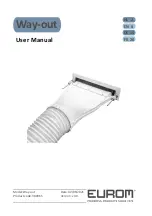
10T8Y1B
VRV-W IV System Air Conditioner
4P399208-1 – 2015.01
Installation and operation manual
33
4
After ten minutes, fully close the liquid line stop valve C and
then, open valve C by turning it open 180° only (do not turn it
open fully).
5
Start the additional refrigerant charge operation, setting [2-20]=
ON.
If it is difficult to charge the refrigerant additionally, decrease the
water temperature or warm the refrigerant tank.
(Warm the refrigerant tank with hot water of maximum 40°C.)
6
After the system is charged with a specified amount of
refrigerant, press the RETURN button (BS3) on the PC board
(A1P) in the outdoor unit to stop the additional refrigerant charge
operation.
7
After the refrigerant charge hose is removed, immediately fully
open the liquid-side stop valve C.
(Otherwise, liquid seal may cause the pipe to burst.)
Perform the test procedure as explained in
"18. Test operation" on
page 40
.
17. Start-up and configuration
17.1. Checks before initial start up
After the installation of the unit, first check the following items. Once
all below checks are fulfilled, the unit must be closed, only then can
the unit be powered up.
1
Installation
Check that the unit is properly installed, to avoid abnormal
noises and vibrations when starting up the unit.
2
Field wiring
Be sure that the field wiring has been carried out according to
the instructions described in the chapter
"14. Electrical wiring
work" on page 22
, according to the wiring diagrams and
according to the applicable legislation.
3
Power supply voltage
Check the power supply voltage on the local supply panel. The
voltage must correspond to the voltage on the identification label
of the unit.
4
Earth wiring
Be sure that the earth wires have been connected properly and
that the earth terminals are tightened.
5
Insulation test of the main power circuit
Using a megatester for 500 V, check that the insulation
resistance of 2 M
Ω
or more is attained by applying a voltage of
500 V DC between power terminals and earth. Never use the
megatester for the transmission wiring.
6
Fuses, circuit breakers, or protection devices
Check that the fuses, circuit breakers, or the locally installed
protection devices are of the size and type specified in the
chapter
"14. Electrical wiring work" on page 22
. Be sure that
neither a fuse nor a protection device has been bypassed.
7
Internal wiring
Visually check the electrical component box and the inside of the
unit on loose connections for damaged electrical components.
8
Pipe size and pipe insulation
Be sure that correct pipe sizes are installed and that the
insulation work is properly executed.
9
Stop valves
Be sure that the stop valves are open on liquid and suction gas
side and HP/LP gas. (Leave the suction gas valve closed in
case of heat pump system.)
10
Damaged equipment
Check the inside of the unit for damaged components or
squeezed pipes.
11
Refrigerant leak
Check the inside of the unit on refrigerant leakage. If there is a
refrigerant leak, try to repair the leak. If the repair is
unsuccessful, call your local dealer. Do not touch any refrigerant
which has leaked out from refrigerant piping connections. This
may result in frostbite.
12
Oil leak
Check the compressor for oil leakage. If there is an oil leak, try
to repair the leak. If the repairing is unsuccessful, call your local
dealer.
13
Air inlet/outlet
Check that the air inlet and outlet of the unit is not obstructed by
paper sheets, cardboard, or any other material.
14
Additional refrigerant charge
The amount of refrigerant to be added to the unit shall be written
on the included "Added refrigerant" plate and attached to the
rear side of the front cover.
15
Installation date and field setting
Be sure to keep record of the installation date on the sticker on
the rear of the upper front panel according to EN60335-2-40 and
keep record of the contents of the field setting(s).
17.2. Monitoring function and field settings
The operation of the outdoor unit can further be defined by changing
some field settings. Next to making field settings it is also possible to
confirm the current operation parameters of the unit.
Below relevant Monitoring mode, mode 1 and field setting mode
(mode 2) settings are explained in detail. How to access them, how to
change the value of the settings and how to confirm them is
explained in
"15. Making field settings" on page 28
. In that chapter,
an example is given on how to make a setting. It is advised to check
this procedure before accessing, checking and changing below
settings.
Once the default situation of the LED indication is confirmed (see
"15. Making field settings" on page 28
), the monitoring mode, mode 1
and mode 2 can be accessed.
Making settings is done via the master outdoor unit, not through slave
unit(s).
Liquid stop valve
Open
Suction gas stop valve
Open
(a)
HP/LP stop valve
Open
(a) In case of heat recovery system only! In case of heat pump system, this
valve always stays closed!
INFORMATION
The additional refrigerant charge operation will
automatically stop after 30 minutes.
If charging is not completed after 30 minutes, perform the
additional charging procedure again.
NOTICE
If the additional refrigerant charge operation stops
immediately, there is a possibility that the unit was
overcharged. In such a case, check the refrigerant volume
again.
NOTICE
Make sure to open all stop valves after charging
refrigerant.
INFORMATION
It is important that all information in this chapter is read
sequentially by the installer and that the system is
configured as applicable.
DANGER: Electrical shock
See
"2. General safety precautions" on page 2
.
Which valves?
State of valves
















































